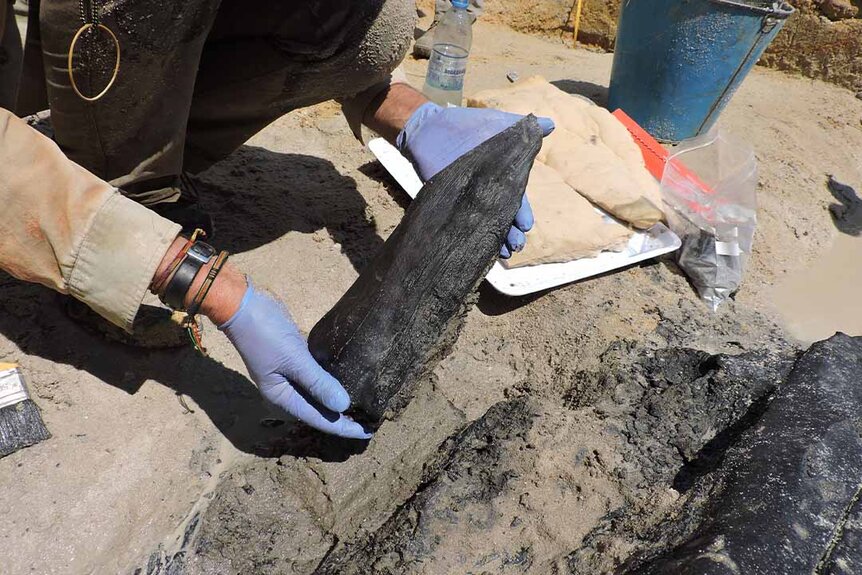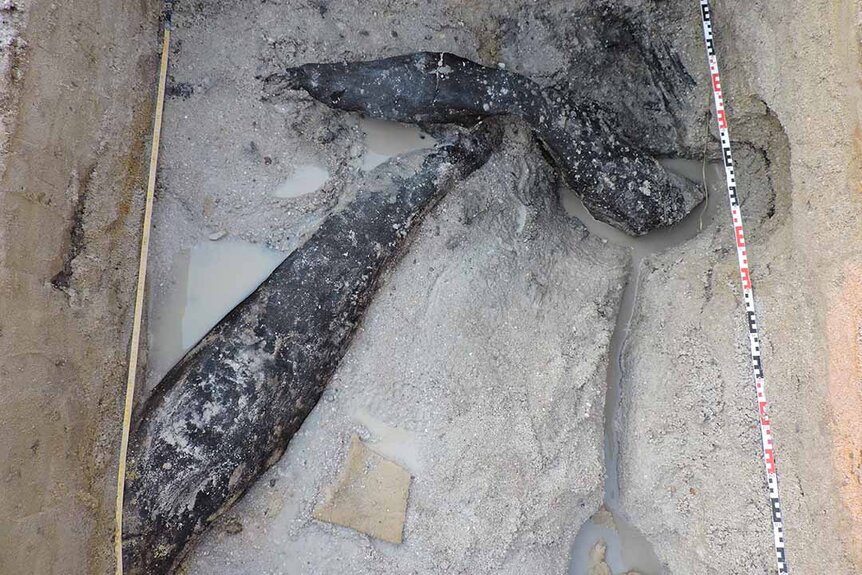Create a free profile to get unlimited access to exclusive videos, sweepstakes, and more!
Scientists Find Ancient Wooden Structure That May Be Oldest Building Ever, Predating Homo Sapiens
Evidence uncovered of worked wood, possibly part of an ancient structure dating back to almost half a million years ago.

In the prehistoric family film The Croods (streaming now on Peacock), primitive people live in caves and, when the world starts to change, they move on in search of a new home. Fanciful as it might be, it’s a pretty good representation of how we think of ancient human life. For thousands of years, small populations of people wandered the Earth following game, water, and the Sun. Only much later, with the advent of agriculture, did people finally settle down in one place for a while.
The conventional wisdom is that people didn’t transition from nomadic lifestyles to more sedentary ones until about 15,000 years ago. A new study published in the journal Nature, however, calls that idea into question. Researchers digging at Kalambo Falls in modern day Zambia have uncovered evidence of worked wood, possibly part of an ancient structure, dating back to almost half a million years ago.
Archaeologists Find Oldest Known Wooden Structure in Zambia
Famed archaeologist J. Desmond Clark first recorded the Kalambo Falls site in 1953 and returned in the ‘60s for an extensive excavation. At the time, Clark uncovered wood within a Stone Age geologic sequence, which he suspected was part of a structure. But he couldn’t prove it. Radiocarbon dating has a limitation of 50,000 years, so neither the wood or the site could be reliably dated. Worse, the wood had been worn smooth by the river, eroding any markings potentially made by stone tools.
RELATED: Surprising Things The Croods Got Right About Ancient Human History
Decades later, with the emergence of new tools and dating techniques, a new generation of archaeologists, led by Larry Barham, professor of Archaeology at the University of Liverpool, have accomplished what Clark only dreamed of. Barham visited Kalambo Falls in 2006 with an expeditionary team who dated the sequence to between 300,000 and 500,000 years. Years later, Barham returned to the site with even better dating techniques, but it had been destroyed by a nearby river. Instead, Barham used Google Earth to identify an alternate site, which turned out to be much more exciting.
“On the riverbank we found big stone tools and I saw a piece of wood sticking out which looked like it had been broken recently,” Barham said. Looking down into the water, he saw another piece of wood that looked like it might fit. Retrieving it, Barham stuck the two pieces back together and realized it was a digging stick used to scrounge for roots and other plant materials.
Over the next four weeks, the team found evidence of modified wood including some which appeared to be part of a structure, across the entire date range of the sequence, suggesting that primitive peoples in the area were modifying wood earlier than we suspected. “What Clark had agonized over, the lack of clear evidence of chop marks, we saw it right there from the start. You can see where the stone tools had just sliced in and left the characteristic stone tool marks,” Barham said.
Human Predecessors Built an Ancient Paradise
All told, the team found five pieces of worked wood spanning tens of thousands of years. To date the material, researchers relied on new luminescence dating techniques capable of determining how long something has been buried.
When materials are buried beneath at least 30 centimeters of dirt they become shielded from sunlight and heat. Consequently, they start soaking up radiation from the surrounding sediment in the crystal structures of quartz and feldspar. Barham compared it to a radiation battery. If you know the rate of charging, you can calculate how long a battery has been charging by looking at the power level. The same principle applies to luminescence dating. Over time, the crystals soak up radiation until they are totally saturated.
RELATED: Ancient Humans Left Footprints in North America 5,000 Years Earlier Than We Previously Thought
Quarts gets full after about 100,000 years, but feldspar has a radiation charge capacity of 500,000 – 600,000 years. “We found wood across the entire 300,000 to 500,000 year period. This wasn’t a one off,” Barham said. The most interesting of their findings is a pair of worked logs which appear to be part of one continuous structure. Incredibly, those pieces of wood were the oldest, dating to 476,000 years ago, predating the emergence of Homo sapiens by roughly 200,000 years.
“Based on our current understanding, Zambia at the time was inhabited by Homo heidelbergensis, that’s the leading candidate. But one of the revelations of research in the last 15 years is there were multiple co-existing species in the human evolutionary record. It’s no longer a unilineal sequences from one thing to the next. Some of them are in the same habitat but doing something slightly different, so they manage to coexist. Maybe it’s another descendant from Homo erectus. This was a big brained species, I’m pretty sure, to come up with something like this structure and these tools,” Barham said.
Barham and colleagues hypothesize the structure, comprised of two modified logs interlocked like Lincoln Logs, was part of the foundation for a raised platform. “I use the term structure in a sort of dictionary sense of two or more parts working together to form a framework. That’s what we have here. The overlying log has been cut so there’s a notch in it, which sits on the underlying tree. They knew what they were doing. What were they doing it for? That’s the $64,000 question… it is some kind of elevated surface, or foundation for a surface, for uses unknown.”
RELATED: Even cave people longed for the old days: Ancient tool recycling driven by stone-age sentimentality
The area in question was wet, almost swampy half a million years ago. Keeping dry might have been a particular challenge and Barham suggested the platform may have been used to store wood, tools, or food. Whatever the purpose, it suggests that at least some primitive humans were more sedentary, even before Homo sapiens showed up.
“You wouldn’t be investing in cutting down trees and making some kind of framework unless you are staying in that place or coming back to that place,” Barham said. “I’ve always assumed in the early stone age people were constantly moving, they were foragers. They would follow the game or a water source. Here you have a little river basic, flood plain, trees all around. No doubt there would have been animals there. You’ve got all the plant food and the wood, why not just stay there? That seems a much more human response, the path of least resistance is just to sit and make the most of this little garden of Eden.”
That’s all Grug ever wanted. Catch The Croods, streaming now on Peacock!




























